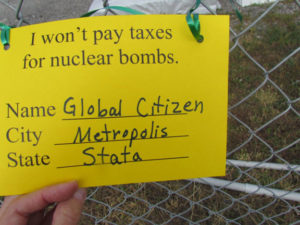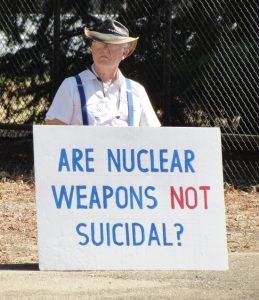There are ample reasons for resisting taxes for war. The insanity of nuclear weapons inspired many when NWTRCC was established in 1982. While there were many other reasons people were resisting paying for wars; it was a welcome opportunity to discuss matters of importance, where we place our priorities, attention and resources. Join NWTRCC for a couple upcoming events this week. On Sunday December 15th we will be hosting a Social Hour at 5pm Central time for people to gather via zoom. You can find information here. Also NWTRCC will be hosting a war tax resistance (WTR) 101 session on Thursday December 19th at 7:30 Central time. You can find information here.

Photo by Susan Miller, Kansas City bomb plant (2011)
Recently the New York Times featured two articles on the modernization of nuclear weapons. The cover of the magazine The Most Dangerous Game: How Nuclear Escalation Spirals Out of Control; another Nuclear Blast in Space Could Change Life as We Know It in the Opinion section. The At The Brink series highlights many issues with the emerging nuclear weapons saga especially with the cost overlays as we continue on with a program that is bankrupting our country and fooling the taxpayers with underestimated costs for programs.
There has not been enough discussion on the issue. Most of the nuclear nonproliferation agreements that were established with countries possessing nuclear weapons have lapsed and the one remaining, the New START has been on shaky ground. Many of the treaties have required years of diplomatic efforts to establish trust and relationships. In 2009, President Obama touted a plan of “Global Zero” in Prague to announce that the US would reduce their nuclear arsenal. Yet the US is scheduled to spend over $1.7 Trillion over the next 30 years to revamp its atomic arsenal. To tally all that spending for nuclear weapons which we hope will never be used comes to almost $57 Billion a year or $108,000 per minute for three decades.
Recently the US Congress passed a defense spending bill for $1Trillion with overall U.S. debt reaching $36 Trillion. One of the resounding themes with the series on nuclear weapons was the need to have conversations on this issue especially as so many of our resources are devoted to it yet so few are aware of taxpayer spending on the programs as much of it is included in the Department of Energy budget. The whole prospect defies logic. The Mutually Assured Destruction (MAD) policy of the 1980’s has morphed into smaller, usable nuclear weapons. The push towards the modernization project amped up in 2010 spans 23 states or all 50 if you include the subcontractors.
Consistent themes with military contracts are cost overruns and delays. At least 20 central projects associated with the nuclear modernization effort are years behind schedule and billions over budget. Again, there has been no significant debate on this topic that siphons off so much of our collective resources to plan, produce and hopefully never use.

Lorin Peters protesting nuclear weapons. Photo courtesy of Lorin Peters.
In one of the articles is described the Project Proud Prophet war games that took place at Ft. Mc Nair in 1983. It seemed to be the early stages of the new modernization of nuclear weapons. Ronald Reagan was dreaming of a ‘Star Wars’ program with the Strategic Defence Initiative in an attempt to create a dome around people in the US to protect them from a MAD policy run amok. While the US and other nuclear nations have been reducing their nuclear warhead stockpiles, they continue to invest in their relevance as a nuclear deterrent.
Years ago, resisters at the Oak Ridge Y-12 plant hosted a 30th anniversary of the Plowshares movement, the Nuclear Resister and nonviolent action near Oak Ridge,TN. The ‘secret city’ that was established with the Manhattan Project of the 1940s has played a significant role in processing of uranium that is essential for nuclear weapons and scheduled well into the future. It is imagined that all of the uranium of the future will be processed here and transferred on highways throughout the U.S. and end up at the Pantex Plant in Texas.

Watch at Hiroshima Peace Museum of the moment the atomic bomb was dropped. Photo from Flickr
In terms of cost overlays, Y-12 is years behind schedule and will not move in till 2031 at the earliest and is at least $540 million over budget. Some say that changing out the U.S. nuclear weapons systems will be the most expensive project in military history. One of the boondoggles of the U.S. was the Sentinel system that was estimated to cost $96 Billion in 2020 but leaped to $141 Billion. The program is scheduled to replace the existing 450 Minutemen III intercontinental ballistic missiles scattered throughout Wyoming, Nebraska, Colorado, Montana and North Dakota. The project is expected to last until 2075 yet the funding for nuclear weapons continues to increase rather rapidly while we are left with arcane weapon systems that become more costly each year as we kick the can down the road, putting the burden on future generations and do not incorporate costs of clean up of nuclear waste.
Post by Chrissy Kirchhoefer
